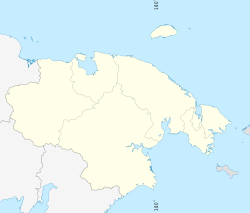| Location | |
|---|---|
| Location | Shelag Range |
| Chukotka Autonomous Okrug | |
| Country | Russia |
| Coordinates | 69°31′N171°59′E / 69.517°N 171.983°E |
| Production | |
| Products | tin |
| History | |
| Closed | 1998 |
| Owner | |
| Company | Pyrkakayskiye Shtokverki (пыркакайские штокверки) |
The Pyrkakay mine was a large open pit mine located in the Shelag Range, Chukotka Mountains, Chukotka Autonomous Okrug, North-eastern Russia.
Pyrkakay represented one of the largest tin reserves in Russia having estimated reserves of 228.5 million tonnes of ore grading 0.23% tin. [1]
The Krasnoarmeysky settlement, built to house the miners, was determined to no longer be economically viable in 1998 and is now a ghost town. [2]
